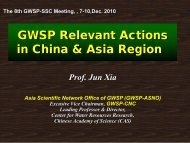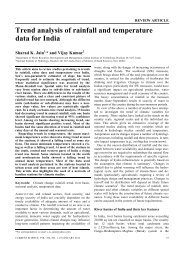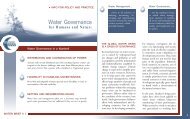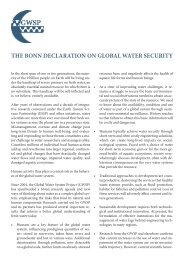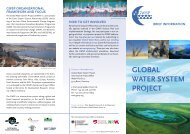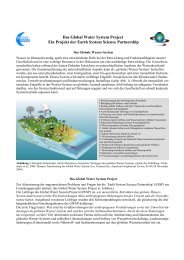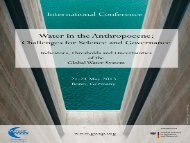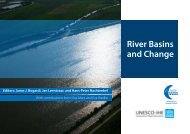Water security for a planet under pressure: interconnected ... - GWSP
Water security for a planet under pressure: interconnected ... - GWSP
Water security for a planet under pressure: interconnected ... - GWSP
Create successful ePaper yourself
Turn your PDF publications into a flip-book with our unique Google optimized e-Paper software.
COSUST-174; NO. OF PAGES 9<br />
2 Open issue<br />
To achieve these goals, seven challenges were <strong>for</strong>mulated<br />
[3]:<br />
Meeting basic (human) needs;<br />
Securing the food supply;<br />
Protecting ecosystems;<br />
Sharing water resources;<br />
Managing risks;<br />
Valuing water; and<br />
Governing water wisely.<br />
While pioneering on its own right, this list does not<br />
identify water as the key factor binding nature and<br />
society. The connections between nature and engineered<br />
water infrastructure, the water–energy–food <strong>security</strong><br />
nexus, the high rates of freshwater biodiversity loss,<br />
and linkages between water and land use must all be<br />
addressed in the quest <strong>for</strong> sustainability [4 ].<br />
Human water <strong>security</strong> is a major political issue: The<br />
Millennium Development Goals (MDGs) [5] call <strong>for</strong><br />
halving by 2015 the proportion of people without sustainable<br />
access to safe drinking water, and have been<br />
extended by adding the same requirement <strong>for</strong> sanitation.<br />
In addition, freshwater issues are embedded, at least<br />
implicitly in nearly all other MDGs. Hence the critical<br />
role of good water stewardship is essential <strong>for</strong> their<br />
achievement. It is essential that the <strong>for</strong>thcoming United<br />
Nations Conference on Sustainable Development —<br />
Rio+20 — acknowledges these complexities and reflects<br />
them in its results and declaration.<br />
A fundamental, yet fragile resource<br />
<strong>Water</strong> is irreplaceable<br />
<strong>Water</strong> is irreplaceable and nonsubstitutable. It is a universal<br />
solvent and, hence, is a vector of compounds and<br />
transport medium, a climate regulator, a carrier of energy,<br />
and cooling and heating agent. Where and when it is in<br />
short supply (droughts) or in excess (floods), it is a major<br />
source of risk, strife and in<strong>security</strong>. Even where water is in<br />
abundant supply, its quality may compromise its use by<br />
humans and its ability to sustain aquatic biodiversity.<br />
This is evident from the presence of nutrients, agrichemicals,<br />
industrial wastes and persistent organic pollutants in<br />
many water bodies, high nitrate levels in groundwaters,<br />
heavy metals in river and lake sediments, and algal<br />
blooms and depleted oxygen that causes fish kills.<br />
Rapid industrial development — without adequate water<br />
treatment or recycling — lead to pollution that endangers<br />
ecosystems and human health, ultimately compromising<br />
water <strong>security</strong>. In addition, residues of hundreds of pharmaceutical<br />
and cosmetic products enter freshwaters<br />
through municipal sewage, despite treatment by stateof-the-art<br />
technology, giving rise to unique ‘chemical<br />
cocktails’ with long-term environmental consequences<br />
that are little <strong>under</strong>stood [6–8].<br />
The global water system<br />
The water cycle (Figure 1) [9 ] represents the circulation<br />
of water through its atmospheric, terrestrial (surface and<br />
subsurface) and marine domains and its different phases<br />
(liquid, vapor and ice). Figure 1 shows the stores of water<br />
and fluxes between these stores as prevailed within 1979<br />
and 2000. Carbon dioxide increases and its associated<br />
temperature increases and land use change over the next<br />
few decades will directly or indirectly lead to changes of<br />
these fluxes and storages [10]. Raising temperatures are<br />
expected to exacerbate increases of water use, and future<br />
water demands will need to be satisfied from a resource<br />
with an increasingly uncertain and variable distribution in<br />
space and time [11].<br />
We have already experienced changing precipitation<br />
patterns, such as increasing rainfall intensity and longer<br />
dry spells, as well as higher evapotranspiration, and an<br />
increased frequency of extreme events such as floods and<br />
droughts. At high latitudes and altitudes more precipitation<br />
is falling as rain rather than snow and the seasonality<br />
of runoff is changing. In some areas new dams may<br />
be needed to increase the water storage capacity to<br />
alleviate droughts, and control floods.<br />
Matters are complicated by the discovery of new pathways<br />
and thresholds within the water cycle that show that<br />
a local focus on water issues presents a serious risk of<br />
failing to <strong>under</strong>stand important larger-scale dynamics<br />
with potentially major and possibly irreversible impacts<br />
on society and nature [4 ]. They include the effects of<br />
deteriorating water quality on aquatic ecosystems and<br />
freshwater fisheries, and the potential exhaustion of overexploited<br />
groundwater resources.<br />
<strong>Water</strong> connects several interlinked, geophysical, socioecological<br />
and economic systems and, in this sense, constitutes<br />
a ‘global water system’ [12 ]. Since the industrial<br />
revolution, when the Earth entered the Anthropocene<br />
epoch [13] in which humans have been changing the<br />
global water system in globally significant ways without<br />
adequate knowledge of the system and its response to<br />
change [4 ].<br />
There are also important uncertainties over the state of<br />
global water resources as well as the dynamics and interconnections<br />
of water, nutrient and material cycles. As far<br />
as the terrestrial part of the water cycle is concerned<br />
Figure 1 indicates water and vapor fluxes which may be<br />
distinguished as ‘blue’ water (the flux of surface and<br />
saturated groundwater flows governed predominantly<br />
by gravitational <strong>for</strong>ces) and as ‘green’ water (taken up<br />
by plants or stored in the unsaturated soil matrix and<br />
returned to the atmosphere through evapotranspiration).<br />
Almost two-thirds of the terrestrial component of the<br />
global water system, about 73,000 km 3 /year is ‘green’<br />
water, ultimately a molecular <strong>for</strong>ces driven feedback to<br />
Current Opinion in Environmental Sustainability 2011, 4:1–9 www.sciencedirect.com<br />
Please cite this article in press as: Bogardi JJ, et al. <strong>Water</strong> <strong>security</strong> <strong>for</strong> a <strong>planet</strong> <strong>under</strong> <strong>pressure</strong>: <strong>interconnected</strong> challenges of a changing world call <strong>for</strong> sustainable solutions, Curr Opin Environ Sustain<br />
(2012), doi:10.1016/j.cosust.2011.12.002



